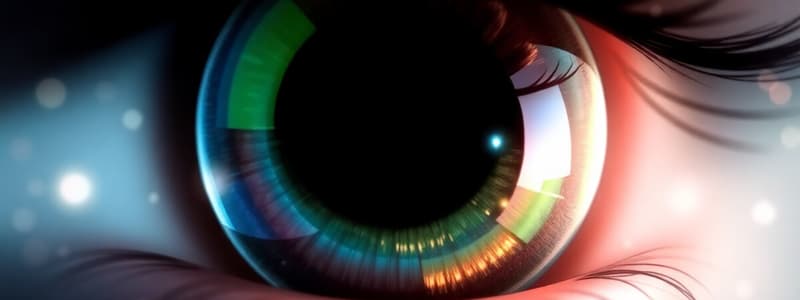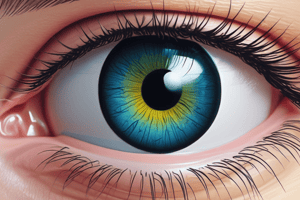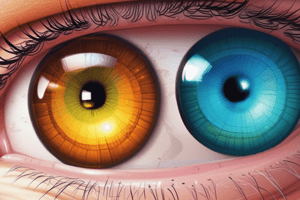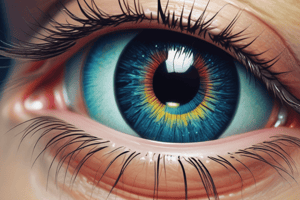Podcast
Questions and Answers
What adjustment is required if the TD is increased by 1.00mm to maintain lens centration?
What adjustment is required if the TD is increased by 1.00mm to maintain lens centration?
- Increase BOZR by 0.10mm (correct)
- Decrease BOZR by 0.10mm
- No change to BOZR needed
- Reduce TD by 0.05mm
What does a reduction in TD imply about the lens fit if the lens is too large on the cornea?
What does a reduction in TD imply about the lens fit if the lens is too large on the cornea?
- The lens will remain unchanged
- The lens will become flatter (correct)
- The lens will improve centration
- The lens will become more steeply curved
What action should be taken if the lens is decentred inferior-nasally?
What action should be taken if the lens is decentred inferior-nasally?
- Decrease TD to realign the lens
- Change BOZR and check centration (correct)
- Prescribe the same lens without modification
- Increase TD without adjusting BOZR
What is the rule of thumb for adjusting BOZR when TD is decreased by 0.50mm?
What is the rule of thumb for adjusting BOZR when TD is decreased by 0.50mm?
If the final lens specification is 7.90 / 10.00 / -4.00DS, what change in BOZR was made from the previous fit?
If the final lens specification is 7.90 / 10.00 / -4.00DS, what change in BOZR was made from the previous fit?
Which of the following best describes the effect of increasing TD on a lens that is already fitted correctly?
Which of the following best describes the effect of increasing TD on a lens that is already fitted correctly?
When recording findings, what aspect is important for assessing the dynamic fit?
When recording findings, what aspect is important for assessing the dynamic fit?
In the context of over-refraction, what does VA stand for?
In the context of over-refraction, what does VA stand for?
What should you conclude if the lens fit is deemed to be flat?
What should you conclude if the lens fit is deemed to be flat?
After a lens adjustment, what information is crucial to include in the final contact lens specification?
After a lens adjustment, what information is crucial to include in the final contact lens specification?
What is the first step in the RGP fitting process?
What is the first step in the RGP fitting process?
What adjustment should be made for a flat RGP lens fit?
What adjustment should be made for a flat RGP lens fit?
When should a toric lens be considered for a patient?
When should a toric lens be considered for a patient?
What is a common issue caused by excessive edge clearance in the steeper meridian of a toric lens?
What is a common issue caused by excessive edge clearance in the steeper meridian of a toric lens?
What effect does increasing the BOZR have on a steep lens fit?
What effect does increasing the BOZR have on a steep lens fit?
What is the purpose of using a spherical center with a toric periphery in RGP lenses?
What is the purpose of using a spherical center with a toric periphery in RGP lenses?
What should be considered first when increasing the TD for a decentred or lid-attached lens?
What should be considered first when increasing the TD for a decentred or lid-attached lens?
What pattern should be expected in a lens fitting on with-the-rule corneas with 2D astigmatism?
What pattern should be expected in a lens fitting on with-the-rule corneas with 2D astigmatism?
When the expected over refraction is plano, what should the adjustment be if the trial lens fit is considered steep?
When the expected over refraction is plano, what should the adjustment be if the trial lens fit is considered steep?
What is a characteristic of an aspheric RGP lens in fitting?
What is a characteristic of an aspheric RGP lens in fitting?
How much should the BOZR be steepened when the OR found is +0.50DS greater than expected?
How much should the BOZR be steepened when the OR found is +0.50DS greater than expected?
What is the expected OR if an alignment fit is achieved with an Rx of -4.50DS and a trial lens that fits flat?
What is the expected OR if an alignment fit is achieved with an Rx of -4.50DS and a trial lens that fits flat?
What action should be taken if the trial lens exhibits inferior-nasal decentering?
What action should be taken if the trial lens exhibits inferior-nasal decentering?
What is likely the effect of increasing the TD in a lens fit?
What is likely the effect of increasing the TD in a lens fit?
If the trial lens is significantly flat compared to the cornea, what modification should be made?
If the trial lens is significantly flat compared to the cornea, what modification should be made?
What should be the new BOZR if the trial lens is originally 7.85mm and is to be steepened by 0.10mm?
What should be the new BOZR if the trial lens is originally 7.85mm and is to be steepened by 0.10mm?
In the case of a toric cornea, what adjustment to the TD can improve the fit of a spherical lens?
In the case of a toric cornea, what adjustment to the TD can improve the fit of a spherical lens?
What is the effect of a decreased TD on the lens fit that is in contact with the eyelid?
What is the effect of a decreased TD on the lens fit that is in contact with the eyelid?
Flashcards
Lens Sag
Lens Sag
The distance between the back surface of the lens and the corneal apex.
Flat RGP Fit
Flat RGP Fit
A lens that is too flat will not touch the cornea at all points.
Lens Diameter (TD)
Lens Diameter (TD)
The vertical distance between the top and bottom of the lens.
RGP Lens Fit
RGP Lens Fit
Signup and view all the flashcards
Steep RGP Fit
Steep RGP Fit
Signup and view all the flashcards
Steep RGP Fit
Steep RGP Fit
Signup and view all the flashcards
Lens Base Curve Radius (BOZR)
Lens Base Curve Radius (BOZR)
Signup and view all the flashcards
Negative Tear Lens
Negative Tear Lens
Signup and view all the flashcards
Positive Tear Lens
Positive Tear Lens
Signup and view all the flashcards
Decentered RGP Lens
Decentered RGP Lens
Signup and view all the flashcards
Change of lens sag
Change of lens sag
Signup and view all the flashcards
Maintaining Equivalent Fit
Maintaining Equivalent Fit
Signup and view all the flashcards
Rule of Thumb: TD and BOZR Adjustment
Rule of Thumb: TD and BOZR Adjustment
Signup and view all the flashcards
Increasing TD and BOZR
Increasing TD and BOZR
Signup and view all the flashcards
Decreasing TD and BOZR
Decreasing TD and BOZR
Signup and view all the flashcards
Over-refraction
Over-refraction
Signup and view all the flashcards
Dynamic Fit Assessment
Dynamic Fit Assessment
Signup and view all the flashcards
Static Fit Assessment
Static Fit Assessment
Signup and view all the flashcards
Ideal Lens Position
Ideal Lens Position
Signup and view all the flashcards
Recording Findings
Recording Findings
Signup and view all the flashcards
Adjusting BOZR using Over-Refraction (OR)
Adjusting BOZR using Over-Refraction (OR)
Signup and view all the flashcards
Over-Refraction (OR)
Over-Refraction (OR)
Signup and view all the flashcards
Expected Over-Refraction (OR)
Expected Over-Refraction (OR)
Signup and view all the flashcards
Actual Over-Refraction (OR)
Actual Over-Refraction (OR)
Signup and view all the flashcards
Back Optic Zone Radius (BOZR)
Back Optic Zone Radius (BOZR)
Signup and view all the flashcards
Why Is BOZR important?
Why Is BOZR important?
Signup and view all the flashcards
Increasing Edge Thickness (ET)
Increasing Edge Thickness (ET)
Signup and view all the flashcards
Decreasing Edge Thickness (ET)
Decreasing Edge Thickness (ET)
Signup and view all the flashcards
Study Notes
Optometry Skills (OPT506) - RGP Lens Fitting
- RGP Lenses: Rigid gas permeable contact lenses.
- Over Refraction: Refraction performed over the contact lens, used to refine BVS for the wearer and adjusting power when required.
- Flat Fit: Lens fitting characteristics including central touch, mid-peripheral pooling, excess edge clearance (>0.5mm), boundary between central touch and pooling, quick NaFl dissipation, unstable and inferiorly decentrating. Excessive movement on blinking with lens possibly crossing limbus. Typically poor comfort, adaptation severely compromised, and inconsistent vision.
- Steep Fit: Lens fitting characteristics including central pooling, trapped bubbles, excessive mid-peripheral touch, very narrow band edge clearance (<0.4mm), poorly defined boundary between central pooling and mid-peripheral touch, NaFl trapped under lens considerably. Limited or no movement on blink, and typically good initial comfort initially.
- Alignment: Apical clearance, slight mid-peripheral touch/alignment, narrow band edge clearance (0.5mm), boundary between centre and mid-periphery undefined.
- Centration: Good initial centration in primary and blinking, with gradual inferior movement with lids apart; 1-1.5mm of smooth vertical movement. Lens edge shouldn't move over limbus.
RGP Fit Assessment
- Fitting Characteristics (Recap): Flat, Steep fitting characteristics relating to fluorescein fit, center, mid-periphery, periphery and border regions, NaFl dissipation, centration, movement on blinking, coverage, and position.
- Over-refraction: Refraction over the contact lens, used to refine the best sphere and cylinder values and optimise vision.
Amending the Fit
- Alignment: No change to BOZR, increase or decrease TD depending on needs.
- Flat Fit Amendment: Reduce BOZR or Increase TD
- Steep Fit Amendment: Increase BOZR or reduce TD
- Decentred/Lid Attached Lenses: Increase TD (considering HVID & corneal astigmatism), increase lid attachment; Reduce TD (reduce lid attachment and lens centration).
Toric Corneas
- Comfort: Reduced when alignment area is reduced; excessive edge clearance in steeper meridians lead to unwanted lid interaction and discomfort; poor centration.
- RGP Behaviour: WTR - lens rocks along steeper meridian or decentrates inferiorly; ATR- lens decentres horizontally; lens flexures; corneal molding.
- When to Consider Toric Lenses: When corneal astigmatism is above 2.00D, or residual astigmatism above 0.75D (ocular minus corneal). Spherical lenses might become unstable with excessive decentrating, and the cornea might become significantly more toric toward the periphery. Large amounts of lens flexure should also be considered.
- Options for Toric Corneas: Alter BOZR based on astigmatism, minimize edge clearance in the steeper meridian; reduce TD; spherical center, toric periphery; aspheric RGP (narrower edge lift to reduce edge clearance); and toric RGP (variety of options including back, front surface toric, bitoric).
RGP and the Tear Lens
- Key factors: Air (n=1), Tear Lens (n=1.336), RGP (n=1.445), and Conea (n=1.376)
- Types of tear lenses: -ve tear lens, Plano tear lens, and +ve tear lens.
Fit Amendment – Flat/Steep Lens
- Flat: To amend a flat fit, steepen the lens through increasing sag. Reduce BOZR or Increase TD.
- Steep: To amend a steep fit, flatten the lens through decreasing sag. Increase BOZR or Reduce TD.
Adjusting the BOZR - Rules of Thumb
- BOZR increase: If increasing the BOZR (flatten), then increase the BVP by +0.25DS for every 0.05mm increase in BOZR
- BOZR decrease: If decreasing the BOZR (steepen), then increase the BVP by -0.25DS for every 0.05mm decrease in BOZR.
Adjusting the TD
- Increase TD to stabilise fit/reduce staining/increase lid attachment. Decrease TD to improve fit of spherical lenses on toric cornea / reduce lid attachment (encourage inter-palpebral fit), excluding amending a fit to steepen or flatten the fit..
Over-refraction
- Over-refraction Definition A refraction performed over the contact lens to refine the lens parameters.
- Procedure Details: VA measurement, Obtain BVS, Duochrome and ±1.00DS test, and finalize VA.
- Recording: Record the power of the final lens used in the trial frame during a refraction.
Over-refraction with RGP
- Alignment of RGP with tear lenses: When RGP lenses are aligned with the cornea, the tear lens does not create unintended power.
- Non-Aligned RGP lenses with Tear lens: If the RGP and cornea are misaligned the tear lens will create an over-power, with plus or minus lenses.
What to do next??
- Use the over-refraction (OR) results to determine corrections in BOZR needed.
- When OR is found to be less/more than the expected to be plano/plano result, the trial lens is determined to be steeper or flatter than the cornea, resulting in 0.05mm being added/subtracted for every 0.25D adjustment in power.
Additional Notes
- These notes cover various aspects of RGP lenses, from fitting characteristics to amending fits, and over-refraction.
- There are also techniques for determining lens parameters when the lens isn't perfectly fitted.
- Procedures are detailed for recording and interpreting results including adjusting the BOZR and TD as fitting lens parameters.
Studying That Suits You
Use AI to generate personalized quizzes and flashcards to suit your learning preferences.




